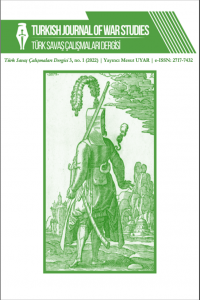Askeri Yöneylem Araştırması: Kökenler, Yakın Geçmiş ve Bugün
Harekat Araştırması (HA) (Türkiye’deki yaygın ismiyle Yöneylem Araştırması, Harekat Analizi)’nın çıkış yeri askeri problem ve ihtiyaçlara bilimsel yontemler ve genel mantık çerçevesinde çözüm bulma çabası ile başlamıştır. Bu makale HA’nın başlangıcı, yakın geçmişi, mevcut uygulamaları ile ilgili özet bilgiler sunmayı amaçlamaktadır. Yüzyıllar boyunca birçok zeki insan askeri yöntem ve araçların daha etkin ve verimli olmasının yaratıcı yollarını bulmaya çabaladıysa da, bu bireysel gayretler bilimsel bir disiplin olarak adlandırılamaz. Yazarın “daha eski daha iyidir” anlayışından uzak durduğunu not ederek, makalenin 2nci Dünya Savaşı esnasında ve hemen öncesinde HA’nın “uygulamalı bir bilim” olarak ortaya çıkışı ve buna ait pratikteki uygulamalara odaklanacağını belirtmek gerekir. 2nci Dünya Savaşı sonrasında işsiz kalan HA analistleri yeteneklerini sivil hayattaki endüstrinin sorunlarına daha iyi, daha etkin ve daha verimli çözümler üretmede kullanmaya başladılar ve bu günümüzde de büyük bir başarı ile devam etmektedir. HA’nın tüm uygulamalarını ve katkılarını tek bir makalede özetlemeye çalışmak çok fazla hırslı bir gayret olacaktır. Bu yüzden, buradaki amaç Askeri Harekat Araştırmasının kaynağı, yakın geçmişi ve mevcut uygulama alanları hakkında özet bilgi sunmaktır.
Anahtar Kelimeler:
askeri harekat araştırması, harekat analizi, yöneylem araştırması, 2nci Dünya Savaşı, uygulamalı bilim, radar
Military Operations Research: Origins, Recent Past, and Present
Operations Research (OR) (also called Operational Research and Operations Analysis) has its origins in tackling military problems and requirements using scientific methods and common sense. This paper aims to provide an overview of its origins, a summary on recent past, and current practices. While many ingenious persons have come up with creative ways to ensure the military means and tools were more effective and efficient over the centuries, not all of these individual efforts can qualify as an organized scientific discipline. Thus, it is important to note that the author refrains from the premise of “the older the better” and focus of the paper is on “practical” emergence of OR as an “applied science” in the years just preceding and during World War II (WW2). Military applications of OR, where it stemmed from, are provided throughout the paper. After WW2, unemployed OR analysts started using their skills on making things better, more effective, and more efficient in the civilian industry and this tradition continues today with great success. It would be over ambitious to attempt to cover all of OR’s applications and contributions in a single paper. Therefore, the attempt here is to provide a glimpse of Military OR’s origins, recent past, current application areas.
Keywords:
military operations research, operations analysis, operational research, World War II, applied science, radar,
___
- Abdollahian, Mark, Brice L. Nicholson, Matthew Nickens, et al. “A Formal Model of Stabilization and Reconstruction Operations” Military Operations Research, Vol. 14, No. 3, pp. 5-30 (2009) https://www.jstor.org/stable/43941197
- David, Israel. “An Adaptive Mix Correction for Fire Support in Combat Operations”. Military Operations Research, Vol. 24, No. 4, pp. 23-36 (2019). https://www.jstor.org/stable/10.2307/26853511
- Gaither, Norman. “Historical Development of Operations Research (1940-1960)”. Academy of Management. Published Online:13 Dec 2017 https://doi.org/10.5465/ambpp.1986.4976815 Available at: https://journals.aom.org/doi/pdf/10.5465/ambpp.1986.4976815
- Klipstein, Michael and Kent D. Wall "A Picture Is Worth a 1,000 Words". Military Operations Research , Vol. 25, No. 4, pp. 23-41 (2020). https://www.jstor.org/stable/10.2307/26957703
- Kucik, Paul and Elisabeth Paté-Cornell. “Counterinsurgency: A Utility-Based Analysis of Different Strategies”. Military Operations Research, Vol. 17, No. 4, pp. 5-23 (2012). https://www.jstor.org/stable/43941526
- Larnder, Harold. “OR Forum—The Origin of Operational Research.” Operations Research 32(2):465-476. (1984)
- Lindsey, George. “Some Personal Recollections of Army Operations Research on Radar in World War II”. Canadian Military History. Vol. 4: Issue 2, Article 8. (1995). Available at: https://scholars.wlu.ca/cmh/vol4/iss2/8
- McCloskey, Joseph F. “OR Forum-British Operational Research in World War II.” Operations Research 35(3):453-470. (1987) https://doi.org/10:1287/opre.35.3.453
- Paciencia, Todd J, Daniel J. Richmond, John J. Schumacher, et al. “A Framework and System for Theater Air Attrition Modeling”. Military Operations Research, Vol. 23, No. 2, pp. 41-60 (2018) https:// doi.org/10.1287/opre.32.2.465
- Rogers, Matthew B, Brandon M. McConnell, Thom J. Hodgson, et al. “A Military Logistics Network Planning System” Military Operations Research, Vol. 23, No. 4, pp. 5-24 (2018) https://www.jstor.org/stable/10.2307/26553094
- Shearer, Robert. “Operations Analysis in Iraq: Sifting Through the Fog of War”. Military Operations Research, Vol. 16, No. 2, pp. 63-71 (2011). https://www.jstor.org/stable/43941476
- Shearer, Robert and Brett Marvin. “Recognizing Patterns of Nation-State Instability that Lead to Conflict”. Military Operations Research, Vol. 15, No. 3, pp. 17-30 (2010). https://www.jstor.org/stable/43941293 Schroden, Jonathan, Rebecca Thomasson, Randy Foster, et al. “A New Paradigm for Assessment in Counterinsurgency”. Military Operations Research, Vol. 18, No. 3, pp. 5-20 (2013). https://www.jstor.org/stable/10.2307/24838477
- Where to Dip? Search Pattern for an Antisubmarine Helicopter Using a Dipping Sensor Author(s): Roey Ben Yoash, Michael P. Atkinson and Moshe Kress Source: Military Operations Research , Vol. 23, No. 2 (2018), pp. 19-40 Published by: Military Operations Research Society Stable URL: https://www.jstor.org/stable/10.2307/26553356
- Başlangıç: 2020
- Yayıncı: Mesut UYAR
Sayıdaki Diğer Makaleler
Deniz Harp Tarihçisi Bir Bahriyeli: Hüseyin Fevzi Kurtoğlu
Kırım ve Osmanlı-Rus Savaşları Arası Dönemde Canlanan Kültürel Hayat (1853-1878 )
Askeri Yöneylem Araştırması: Kökenler, Yakın Geçmiş ve Bugün
Strateji Düşüncesinde Yorum ve Tahrifat: Clausewitz Olayı
Uluslararası İlişkilerin Bir Alt Disiplini Olarak Güvenlik Çalışmaları
